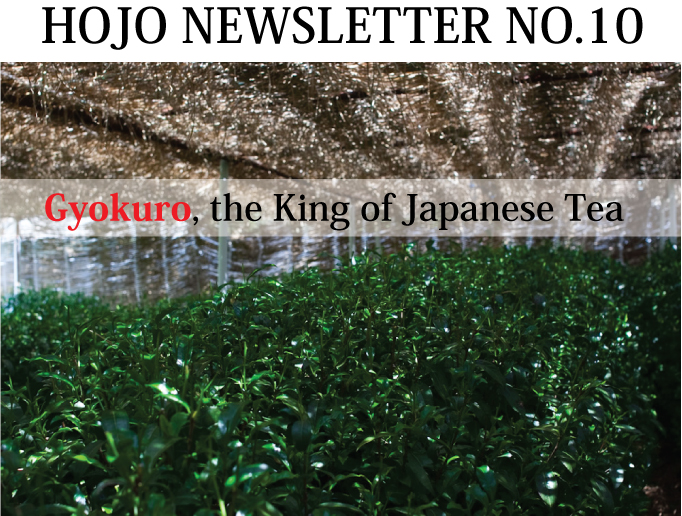
Greetings!
I am Akira Hojo from HOJO TEA SHOP. You are receiving this email because you have registered on our email list when you visited my shop at The Gardens Mall in Mid Valley City, Kuala Lumpur or you have registered on our mailing list on the website.
As our latest news, we have set up "FACEBOOK". Please visit our FACEBOOK where you can check out what's news in HOJO TEA.
http://www.facebook.com/hojotea
In this newsletter, I would like to explain the premium and unique Japanese green tea that is called "Gyokuro". This tea is available in our outlet and you can feel free to taste it if you feel any interest on it.
Go to HOJO Websie Main Page >>
Have you ever heard of the tea called “Gyokuro”?
The direct translation in Japanese for Gyokuro is “Dew of Jade” (玉露 ) and it is such a fabulous name. This tea is not a common tea in Japan. It is so rare that many Japanese themselves never had a chance to drink this tea before in their life.
 |
 |
|
| Gyokuro | The leaf of Gyokuro is very vivid green |
If you go to a Japanese restaurant, they normally serve so-called “Ocha”. Ocha means “tea” in Japanese. Usually the type of tea served in Japanese restaurant is common sencha.
As for Gyokuro, its flavor is very different from sencha. Gyokuro reminds us of fresh seaweed or milky flavor in addition to the fresh vegetal flavor of green tea. This particular flavor is made thanks to a very unique cultivating technique.
As a matter of fact, Gyokuro is not the name referring to a specific type of tea cultivar or a particular process that is used to produce it. The same type of tea cultivar such as “Yabukita” is used for both Sencha and Gyokuro. The process of making Gyokuro is almost the same as the one for making sencha as well. The secret of Gyokuro exists in its tea garden. The tea garden is completely under the shade. The garden is fully covered by sheets to block out direct sunshine. The tea trees receive less sunshine due to the sheets. The frame is constructed on top of tea garden and the sheet is placed over the frame. The Gyokuro garden looks like a warehouse or a military base.
| |
|
|
| The tea garden of Gyokuro is fully covered. It looks like warehouse. | Gyokuro is usually plucked by hand |
When tea tree receives less sunshine, tea tree will have to make an effort for survival. Firstly, the tea leaves increase in size in order to absorb more sunshine. Secondly, the tea leaves increases the number of green pigment that is called chlorophyll. With more chlorophyll, the more efficient the tea leaves can carry out photosynthesis. In addition, a lot of nutrients that has been stored since when tea leaf was young are not consumed and remained in the tea leaf. This is how Gyokuro with its distinctive flavor is produced.
You can brew Gyokuro in cold water as well, as its leaf is very delicate. All you need to do is to place a small quantity of tea leaf in a PET bottle or a glass bottle, then pour some drinking water and keep in refrigerator. Tea is ready within 1 hour. Being kept in the refrigerator, the quality of cold-water brewed Gyokuro remains fresh even up to a few days.
It is also ordinary practice to eat the brewed leaf of Gyokuro. The leaves are so delicate and tender. I know many customers who enjoy eating brewed Gyokuro leaf with porridge, salad or risotto.
Successful candidates can look forward to a highly competitive remuneration package with attractive scheme. On-job training and site training at oversea tea gardens will be provided for the stable staff.
Starting salary range RM1,600 to RM2,500
Work location: Kuala Lumpur, Mid Valley, The Gardens Mall or Office at Desa Sri Hartamas
http://www.hojotea.com/info_e/profilee.htm
Working Experience: Not required in particular. Fresh graduate are encouraged to apply.
Malaysia residence
Language: Able to write and speak both in English and Chinese
Age: 22 years old and above.
If you are interested, please send a resume to us at following email address:
![]()
As far as we know, Hebizuka Gyokuro is produced at the garden located at the highest altitude among the Gyokuro gardens in Japan. Most Gyokuro gardens are located at 200-300m above sea level, while Hebizuka Gyokuro garden is located at around 800m. Comparatively, this Gyokuro gives strong after taste that last a long time in the throat.
Another unique characteristic of Hebizuka Gyokro is that this tea is made with withering process. Usually Japanese green tea has not undergone withering process and therefore it gives a greenish vegetal flavor. As for Hebizuka Gyokuro, it is withered for 24 hours right after the harvesting of fresh leaves. Thanks to the moderate ripening process, Hebizuka Gyokuro gives a unique flowery flavor.
| |
|
| The Gyokuro leaf grown under the shade becomes very vivid green. |